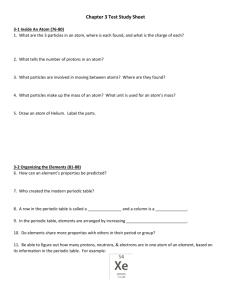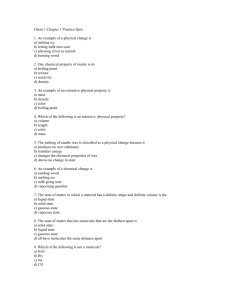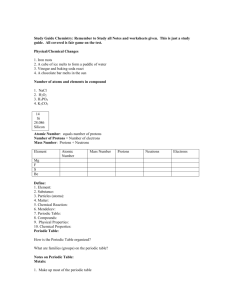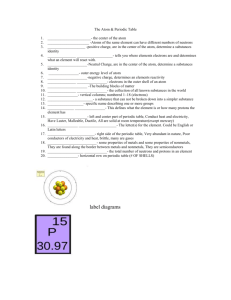3rd Grading Period Exam Study Guide 6th grade Chapters 4, 6, 7
advertisement
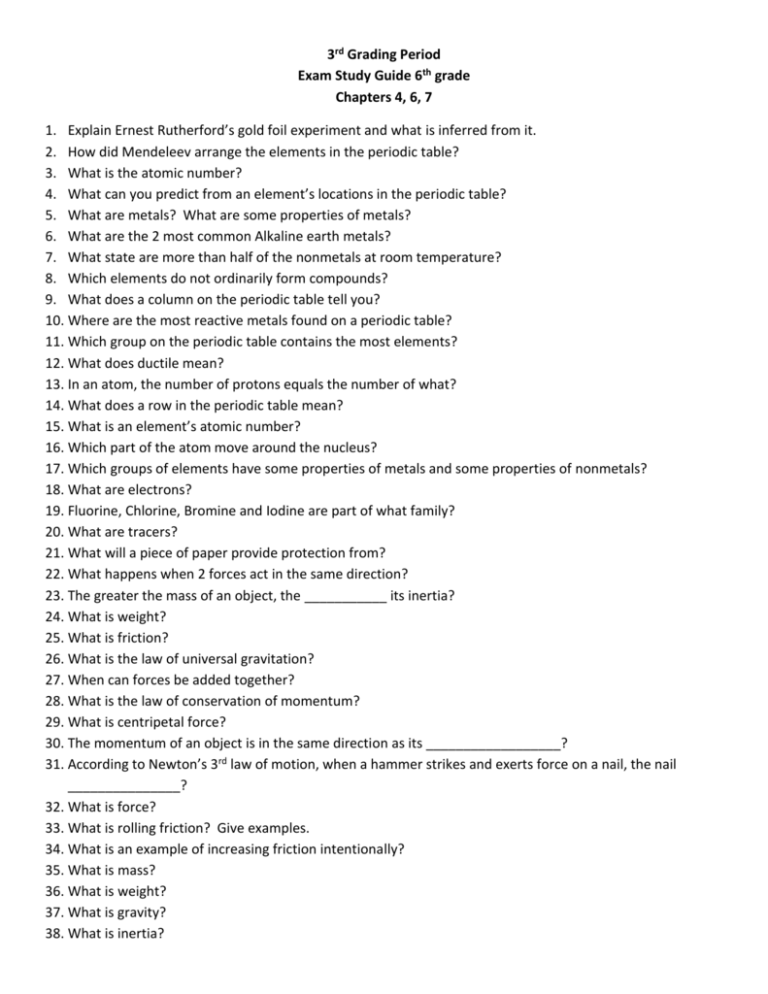
3rd Grading Period Exam Study Guide 6th grade Chapters 4, 6, 7 1. Explain Ernest Rutherford’s gold foil experiment and what is inferred from it. 2. How did Mendeleev arrange the elements in the periodic table? 3. What is the atomic number? 4. What can you predict from an element’s locations in the periodic table? 5. What are metals? What are some properties of metals? 6. What are the 2 most common Alkaline earth metals? 7. What state are more than half of the nonmetals at room temperature? 8. Which elements do not ordinarily form compounds? 9. What does a column on the periodic table tell you? 10. Where are the most reactive metals found on a periodic table? 11. Which group on the periodic table contains the most elements? 12. What does ductile mean? 13. In an atom, the number of protons equals the number of what? 14. What does a row in the periodic table mean? 15. What is an element’s atomic number? 16. Which part of the atom move around the nucleus? 17. Which groups of elements have some properties of metals and some properties of nonmetals? 18. What are electrons? 19. Fluorine, Chlorine, Bromine and Iodine are part of what family? 20. What are tracers? 21. What will a piece of paper provide protection from? 22. What happens when 2 forces act in the same direction? 23. The greater the mass of an object, the ___________ its inertia? 24. What is weight? 25. What is friction? 26. What is the law of universal gravitation? 27. When can forces be added together? 28. What is the law of conservation of momentum? 29. What is centripetal force? 30. The momentum of an object is in the same direction as its __________________? 31. According to Newton’s 3rd law of motion, when a hammer strikes and exerts force on a nail, the nail _______________? 32. What is force? 33. What is rolling friction? Give examples. 34. What is an example of increasing friction intentionally? 35. What is mass? 36. What is weight? 37. What is gravity? 38. What is inertia? 39. What is momentum? 40. How can you increase the momentum of an object? 41. When is the exception to the total momentum of a group of objects being conserved? 42. What is a satellite? 43. What is the formula for speed? 44. When you know both the speed and direction of an object’s motion, then you know what? 45. What is slope? 46. What is acceleration? 47. Which of the following is the SI unit of acceleration? 48. On a graph showing distance vs. time, a horizontal line represents what? 49. Who uses the International System of units? 50. An object changing direction is an example of what? 51. List an example of deceleration. 52. What is the average speed of a car traveling 300km in 3 hours? 53. When an object’s position relative to another object is changing, it is in _______________? 54. What is the basic SI unit of length? 55. What is a reference point? 56. What is average speed? 57. What is the average speed of a bicyclist traveling 30km in 2 hours? 58. If an object moved in the same direction and at a constant speed for 4 hours, what did not change? 59. To determine the acceleration of an object moving in a straight line, you must calculate the change in its speed during each unit of what? 60. What does a straight line show in a speed vs. time graph? Essays 61. Explain how it is possible for an atom to have no charge even though it is made up of protons, neutrons, and electrons. 62. The mass of an atom may be determined by adding the masses of the protons and neutrons in the nucleus. Why is it unnecessary to include the electrons when determining the mass of an atom? 63. What contribution did the Russian Chemist Dmitri Mendeleev make to chemistry? What was he able to do to show the value of his contribution? 64. Compare the properties of metals and nonmetals. 65. Explain how to find the average speed of a car that travels 300km in 6 hours. Then find the average speed.


